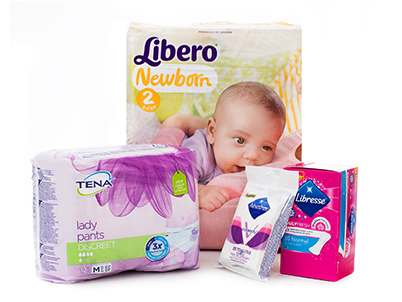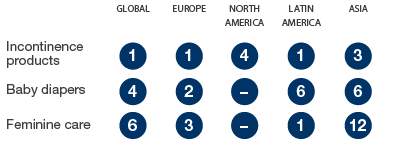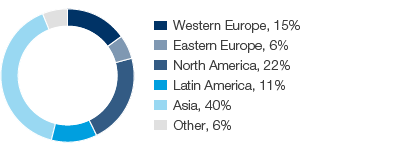Market
In 2016, net sales in the Personal Care business area amounted to approximately SEK 34bn. The globally leading brand for incontinence products, TENA, is the largest brand in Personal Care, a “billion dollar brand” with annual net sales exceeding SEK 15bn. At the end of the year, SCA had production at 27 plants in 21 countries.

Shifts in global demographics such as population growth – due primarily to a lower infant mortality rate and increased longevity – and higher disposable income point to continued favorable growth for personal care products. The effect of higher disposable income is that more people prioritize hygiene when food and housing needs have been, or are in the process of being, satisfied. Consequently, demand for personal care products is rising in emerging markets. The growth potential for personal care products is also greatest in emerging markets where market penetration is significantly lower than in mature markets and where urbanization, improved infrastructure and the retail trade are evolving rapidly. One example of the lower market penetration in emerging markets is that the consumption rates for baby diapers and incontinence products per capita per year in Asia are only about one-fifth and one-sixth, respectively, of those in Western Europe. In mature markets, baby diapers and feminine care products have attained high market penetration. However, market penetration for incontinence products in mature markets is still low for certain product segments, particularly among men.

Market growth is positively impacted by global hygiene and health trends and increased awareness of the importance of hygiene to improve health and avoid diseases, especially in emerging markets.
Incontinence, which is classed as a disease by the World Health Organization (WHO), affects 4–8% of the world’s population, corresponding to approximately 400 million people. Many indicators point to the proportion of people affected increasing on a global scale as a result of an aging population. By 2020, the population of the world over the age of 60 is expected to have increased by 13% and pass the one billion mark. The occurrence of incontinence among people over the age of 65 is expected to be between 15 and 20%.
During 2016, the European and North American markets for incontinence products in the health care sector showed higher demand, but with continued price pressure as a result of fierce competition. The European and North American retail markets for incontinence products showed high growth. Emerging markets showed higher demand for incontinence products. The global market for incontinence products was characterized by continued high competition. In Europe, demand for baby diapers and feminine care products was stable. In emerging markets, demand increased for baby diapers and feminine care products. The global market for baby diapers and several markets for feminine care products were characterized by increased competition and campaign activity.
SCA’s competitors in personal care include Kimberly-Clark, Procter & Gamble and Unicharm.
SCA’s market positions

Data is based on market data and SCA’s estimates.
Personal care products – global market

Data is based on market data and SCA’s estimates.
Examples of brands

